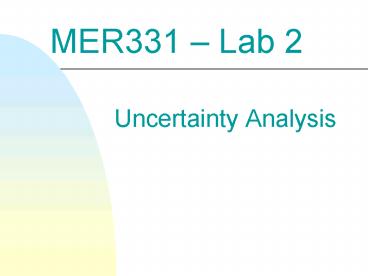MER331 Lab 2 PowerPoint PPT Presentation
1 / 20
Title: MER331 Lab 2
1
MER331 Lab 2
- Uncertainty Analysis
2
Error Sources
- The measurement process consists of three
dis-tinct steps calibration, data acquisition,
and data reduction - calibration error
- data acquisition error
- data reduction error
3
Uncertainty Analysis
- Error - difference between true value and
measured value. - Two general categories of error (exclude gross
blunders) - Fixed error remove by calibration
- Random error quantify by uncertainty analysis
- The term uncertainty is used to refer to a
possible value that an error may have
4
Stages of Uncertainty Analysis
- Design Stage Uncertainty Analysis
- Uncertainty analysis can be used to assist in the
selection of equipment and procedures based on
their relative performance and cost. - Advanced-Stage and Single Measurement Uncertainty
Analysis - Consider procedural and test control errors that
affect the measurement
5
Uncertainty Analysis
- m Kt(rball-rfluid)
- How do I find uncertainty in m if I have
uncertainty in K, t, rball,and rfluid.? - Three steps
- Estimate uncertainty interval for each measured
quantity - State the confidence limit on each measurement
- Analyze the propagation of uncertainty into
results calculated from experimental data.
6
Estimating Uncertainty Interval
- If you have a statistically significant sample
use 2s for a 95 confidence interval. (1st
order analysis) - General Practice in engineering is 95
confidence of 20 to 1 odds. - Otherwise use ½ smallest scale division as an
estimate. (0th order analysis) - Technique due to Kline, S.J., and McClintock,
F.A., Describing Uncertainties in Single Sample
Experiments, Mechanical Engineering, 75, 1953.
7
Propagation of Uncertainty -The Basic Mathematics
- The value of dxi represents 2s for a single
sample analysis. The result, R of an experiment
is assumed to be calculated from a set of
measurements - R R(X1, X2, X3,, XN)
- The effect of the uncertainty in a single
measurement (i.e. one of the Xs) on the
calculated result, R, if only that one X were in
error is
8
The Basic Mathematics
- When several independent variables (Xs) are used
in calculating the Result, R, the individual
terms are combined by a root-sum-square method
(Method due to Kline and McClintock (1953)) - In most situations the overall uncertainty in a
given result is dominated by only a few of its
terms. Ignore terms that are smaller than the
largest term by a factor of 3 or more.
9
Example 1
- For a displacement transducer having a
calibration curve y KE2, estimate the
uncertainty in displacement y for - E 5.00 V, dE 0.01 V
- K 10.10 mm/V2, dk 0.10 mm/V2
- (95 confidence).
10
Example 1
11
Uncertainty as a Percentage
- In most situations the overall uncertainty in a
given result is dominated by only a few of its
terms. Ignore terms that are smaller than the
largest term by a factor of 3 or more. - It is difficult (impossible) to compare errors
with different units associated with them (e.g.
how big is a 2 gram error compared to a 2 second
error?) - To solve this we nondimensionalize the errors
12
So, as a percentage
13
Uncertainty Analysis (Product form Equations)
- .
- If
- Then
- The exponent on Xi becomes its sensitivity
coefficient
14
Example 2
- For a displacement transducer having a
calibration curve y KE2, estimate the PERCENT
uncertainty in displacement y for - E 5.00 V, dE 0.01 V
- K 10.10 mm/V2, dk 0.10 mm/V2
- (95 confidence).
15
Example 2
- If
- Then
16
Zero-Order Uncertainty
- At zero-order uncertainty, all variables and
parameters that affect the outcome of the
measurement, including time, are assumed to be
fixed except for the physical act of observation
itself. - Any data scatter is the results of instrument
resolution alone uo.
17
Higher-Order Uncertainty
- Higher order uncertainty estimates consider the
controllability of the test operating conditions. - For a first order estimate we might make a
series of measurements over time and calculate
the variation in that measurement. The first
order uncertainty of that measurand is then - u1 2s at (95)
- Note Assuming we make enough measurements
18
Nth-Order Uncertainty
- As the final estimate, instrument calibration
characteristics are entered into the scheme
through the instrument uncertainty, uc. A
practical estimate of the Nth order uncertainty
uN is - Uncertainty analyses at the Nth order allow for
the direct comparison between results of similar
tests obtained using different instruments or at
different test facilities.
19
Uncertainty Analysis
- rfluid m/V
- How do I find uncertainty in r?
- Three steps
- Estimate uncertainty interval for each measured
quantity, (m and V) - State the confidence limit on each measurement
- Analyze the propagation of uncertainty into
results calculated from experimental data.
20
Report Results at uN level
Nth order Uncertainty
First-order Uncertainty u1 gt u0
Zero- order Uncertainty u0 1/2 resolution

